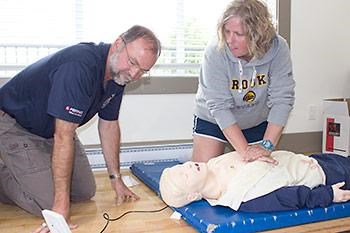Brooks Secondary School teachers will be teaching children to save lives in another way this coming September. On Tuesday, June 25, teachers received training to teach their students how to use an automated external defibrillator (AED).
The CPR (cardiopulmonary resuscitation) program at Brooks is put on through the Advanced Coronary Treatment (ACT) Foundation, a national charity that aims for free CPR training to be a mandatory program in Canadian high schools.
The program had already been established at Brooks for several years, but a contribution from RBC allowed the school district to add an AED training component. Brooks now has four AED training units and mannequins students can use.
The AED addition to the curriculum comes after a slew of new AED units have been installed in the Powell River area, including at the airport and in Lund.
“Now that we have AEDs that are slowly being placed around the community, [students] will know where to get them when they need them, and how to use them,” explained paramedic and CPR training instructor Greg Laureta, who volunteered to teach the course. Other AED locations include three at the Powell River Recreation Complex and one at Tla’amin Community Health.
Six teachers from School District 47 were trained, which will result in 200 students being trained annually. Students are taught the skills in their grade 10 physical education class.
Other groups involved in the training were BC Emergency Health Services and BC Ambulance Service.
Advocates of the program hope it will improve response rates in the Powell River area. “If we teach all the grade 10s to do this ... all of a sudden we’ve blanketed the whole town with people that know chest compressions and how to run an AED,” explained emergency doctor David Mann. “More people will survive when they have a heart attack.”
If a heart attack victim doesn’t receive any life-saving procedures, they have about a five per cent chance of surviving, said Mann. With CPR and the use of an AED, the odds improve to about 15 to 20 per cent.
So far, the ACT Foundation has established CPR programs in 220 public schools across Canada, reaching over 250 thousand students.
“We are thrilled with the support from our partners,” said Sandra Clarke, executive director of the ACT Foundation. “These are lifesaving skills that students will be able to bring to their current and future families and communities.”



